What Is A Margin In Writing
You've seen it before. A child is writing a journal entry or a writing response on a piece of paper and each line of the paragraph creeps in toward the center of the page. The margins in their handwriting are just all over the place! By the end of the passage, the left margin is half way across the page. You might see them start halfway across the page and try to squash letters in by the time they get to the right side of the page. It's hard to read and even the kiddo has trouble reading back over their work. The thing is, the student may not even be aware they are writing like this…
When a child has poor use of margins when writing, there is typically a problem with spatial organization and page orientation.
Decreased spatial awareness can happen due to trouble with visual perceptual awareness.
It may carry over to handwriting that appears very messy with words that are squashed up against one another or spaced with very large spaces between letters.
Today, I've got some tips for helping with spatial awareness in handwriting, including how to help with margins when writing. These tips can help kids with writing on the paper and using handwriting that is legible so they can come back and read what they've written. (And so the teacher or parent can read that handwriting too!)
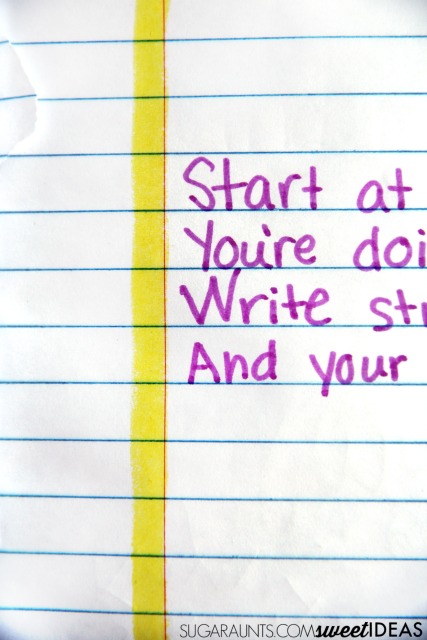
Visual perceptual skills are needed for so many functional skills. You'll find easy and fun ways to work onvisual perceptual skills through play here. These are creative ways to work on the underlying issues that might be playing into trouble with margin use in handwriting as a result of spatial awareness difficulties.
This post contains affiliate links.
Why kids struggle with margins in handwriting
So, why do we see those handwriting samples where the lines of written work slowly creep over to the middle of the page? With each line that the student writes, they start writing just a bit more away from the margin?
There could be a few different things going on here that impact margin use:
1. There could be a visual perception difficulty going on. Specifically, it could be a problem with visual spatial relations. Spatial relations, or poor spatial awareness difficulties shows up frequently in handwriting. This presents as poor spacing between letters and words, poor use of margins, or written work that drifts in toward the center of the page. Kids may struggle with knowing when to stop writing on the end of a line of the page and try to squash the material in rather than stopping to move to the next line. Left to right use of paper or writing spaces on worksheets can be a problem. Other size aspects of handwriting including letter size, placement of letter "parts", and consistency in sizing can be difficult for the child with visual spatial concerns. Spatial relations can also impact placement of objects or the child's body parts in relation to other objects, other people, or in movement. This can show up as poor coordination, poor balance, poor self-awareness, poor self-confidence, and even impaired social emotional relations.
Spatial awareness is the ability to perceive the world around one's self and position themselves or objects accordingly. Awareness of space relates a lot to the proprioceptive and vestibular systems as well as the visual system. A child who demonstrates poor spatial awareness in handwriting tasks most likely shows some variances of difficulty with gross motor movement, understanding directions, abstract concepts, and language.
2. There could be an oculomotor component. The movement of the eyes in activities is complex! When we see issues with margins, there could be a couple of oculomotor issues happening. At a basic level, the eyes move to take in information and process that information for use. One oculomotor skill that may be in play with margin trouble are visual saccades/visual scanning. Saccades are the ability to visually scan information. Saccades require the ability to fixate on information in the visual fields. Saccadic movement, or more commonly known as visual saccades, is the ability of the eyes to move in synchrony from point A to point B rapidly WITHOUT deviating from the path. When kids move their eyes to the next line of a paper, they jump to the nearest anchor (which will be the letter above on the last line of text they just wrote.) They will then scoot their pencil over and under that letter, resulting in written work that drifts in toward the middle of the page. Here is more information on visual saccades and learning.
We cover more about oculomotor skills and how they result in functional issues in reading, writing, and daily activities in the free Visual Processing Lab here on The OT Toolbox.
3. It might be developmental. In this case, kids just need more experience with writing paragraphs of text. They place their written material anywhere on the page or drift over on the line when starting to write. Visual and verbal cues…and more practice can help. Even children without visual perception difficulties may tend to drift their handwriting in toward the middle of the page as they write paragraphs. This is especially apparent in free writing, journal writing, or writing prompts. You will see that children who are developing their ability to form thoughts in paragraph form. As they write, it is common to see the lines start to drift toward the middle of the page. Here is more information on development of eye-hand coordination.
3. It might be speed of writing or visual inattention. Basically, you might see a kiddo who just isn't paying attention when they are writing. In this case, students might be writing so quickly that they are focusing on the content of the writing versus the layout of the page and where they are placing their written work. This happens when kids are taking notes and trying to quickly get the information on the page. You may also see the lines of text drifting over during free writing or timed writing tasks. In these cases, a visual cue can help but it might just take a verbal prompt. Point out how the margins are creeping over and see if that helps. Here is more information on visual attention.
QUICK tips for improving spatial awareness:
For some of the issues mentioned above, such as an underlying visual perceptual or oculomotor problems, further help and interventions will be needed. Seek out assessment from an occupational therapist for individualized treatment and intervention plans. Use of our visual processing checklist to help to identify a specific area related to visual processing needs.
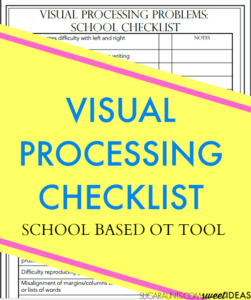
This visual processing checklist can be a helpful tool in screening for visual processing difficulties prior to a full evaluation. It can be a way to collect qualitative information to include in assessment write-ups as well.
Try some of these strategies to help with margins:
- There are ways to accommodate for difficulties with spatial awareness. One quick tip is to use a highlighted left margin. This is a great way for those kids whose writing drifts over to the middle of the page as they write or kids who start in the middle of the page.
- Use stickers placed along the right margin of to cue the student that they are nearing the edge of paper when writing.
- Place a thin piece of tape along the left margin. This can serve as a visual and physical cue as the place to start writing. It's a visual anchor that helps with visual scanning.
- Draw boxes for words on worksheets for them to write within.
- Place small green dots on each line along the left margin. These are the "green lights" so students know where to start writing. Place small red dots on each line along the right margin. These are "red lights" so students know where to stop writing.
- Spacing Tools for spacing between words or letters.
- Draw a red stop sign at the right margin.
- Graph paper Try 1/2 inch wide rule first.
- Raised line paper
- Slant board
- Try smaller width of lines instead of primary paper.
- RediSpace paper has a green line along the left margin and a red line along the right margin.
- Try using a spacing tool pointer stick. You can easily make your own!
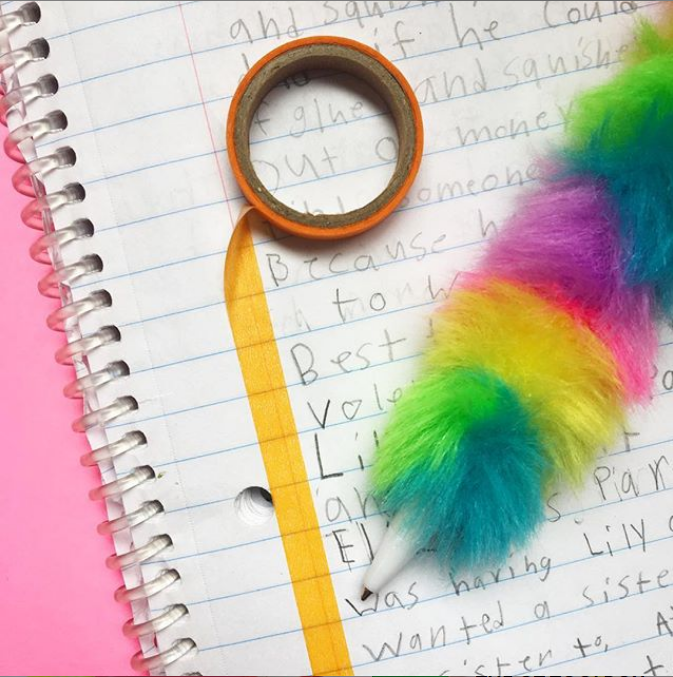
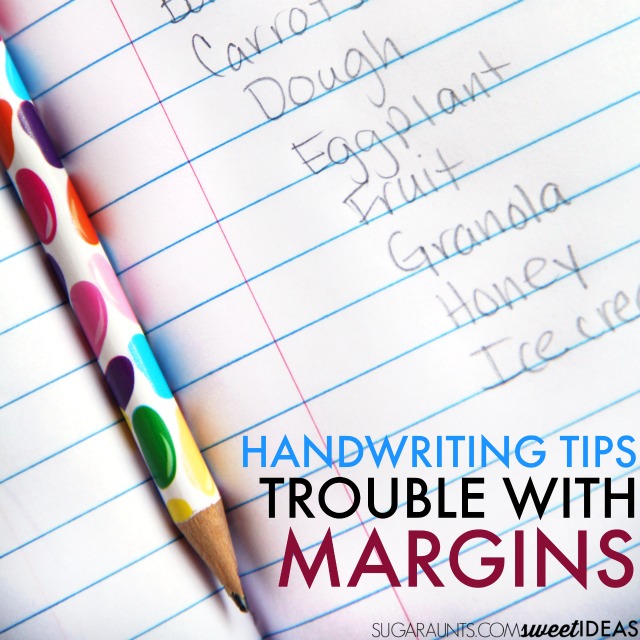
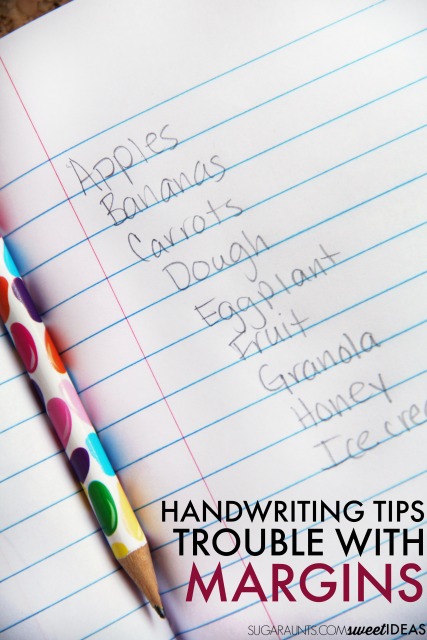
This activity is part of our month-long handwriting series where we are sharing creative and easy ways to address common handwriting issues in our30 Easy Quick Fixes for Better Handwriting series.
What Is A Margin In Writing
Source: https://www.theottoolbox.com/spatial-awareness-margins-in-handwriting/
Posted by: mckeelecladmands.blogspot.com

0 Response to "What Is A Margin In Writing"
Post a Comment